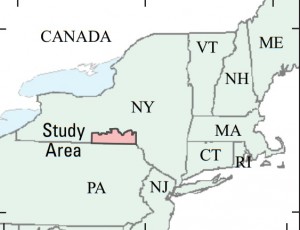USGS study: methane common in groundwater of New York’s Southern Tier
-
Marie Cusick
Naturally-occurring methane is common in groundwater supplies throughout south-central New York, according to a study published today by the U.S. Geological Survey.
Samples were collected from 66 water wells in five southern New York counties along the Pennsylvania border in the summer of 2012.
USGS
The study area included about 1,800 square miles and includes all or part of Broome, Tioga, Chemung, Chenango, and Delaware Counties.
Researchers found that methane concentrations varied widely, but were more likely to be high in valleys, and low in upland areas. The study excluded water wells within one mile of known gas wells (active, exploratory, or abandoned).
Methane was present at high enough levels to prompt mitigation or monitoring in 15 percent of the samples.
USGS hydrologist and lead author Paul Heisig says it was important to establish an understanding of naturally occurring methane concentrations while New York’s moratorium on hydraulic fracturing is still in place.
“It seemed a prudent thing to do, because of the experience in Pennsylvania,” he says. “They would have benefited to have baseline reference data.”
So-called “tap water torches” and videos of people lighting their drinking water on fire have been widely circulated since the shale gas drilling boom began. The industry correctly points out that methane is naturally occurring, however gas development is also known to cause methane to migrate into drinking water supplies.
Since Pennsylvania does not regulate private water wells, it has been difficult in some case to determine whether instances of methane in water pre-date gas drilling activities. Companies now generally do baseline water testing before they begin development, and last year’s Act 13 expanded the presumption of liability for water contamination.
The USGS study was primarily funded by the New York State Energy Research and Development Authority.

















